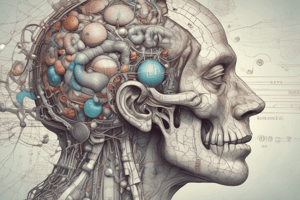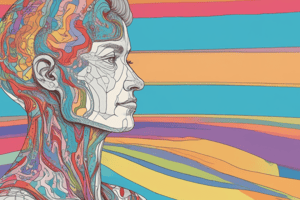Podcast
Questions and Answers
What is the main drug of choice for treating muscle injury leading to myoglobinuria and renal failure?
What is the main drug of choice for treating muscle injury leading to myoglobinuria and renal failure?
- Diphenhydramine
- Clozapine
- Bromocriptine
- Dantrolene (correct)
Which of the following is considered the drug of choice for treatment-resistant schizophrenia (TRS)?
Which of the following is considered the drug of choice for treatment-resistant schizophrenia (TRS)?
- Dopamine agonists
- Second-generation antipsychotics
- Clozapine (correct)
- Amantadine
How long should a patient be antipsychotic-free before restarting treatment after experiencing acute dystonia?
How long should a patient be antipsychotic-free before restarting treatment after experiencing acute dystonia?
- 2 weeks (correct)
- 1 month
- 6 weeks
- 4 weeks
What is the mechanism of action for clozapine that contributes to a reduced risk of extrapyramidal symptoms (EPS)?
What is the mechanism of action for clozapine that contributes to a reduced risk of extrapyramidal symptoms (EPS)?
Which of the following treatment methods is NOT advised for managing acute dystonia?
Which of the following treatment methods is NOT advised for managing acute dystonia?
What is one of the consequences of continuing muscle damage in patients with acute dystonia?
What is one of the consequences of continuing muscle damage in patients with acute dystonia?
What is a common side effect of antipsychotics that may be seen alongside acute dystonia?
What is a common side effect of antipsychotics that may be seen alongside acute dystonia?
Which dopamine agonist can be considered in the management of acute dystonia?
Which dopamine agonist can be considered in the management of acute dystonia?
What is the primary treatment for acute dystonia after the onset of symptoms?
What is the primary treatment for acute dystonia after the onset of symptoms?
Which of the following symptoms is least likely associated with acute dystonia?
Which of the following symptoms is least likely associated with acute dystonia?
Which group of patients is most commonly affected by acute dystonia?
Which group of patients is most commonly affected by acute dystonia?
What would be the most appropriate prophylactic treatment for a patient at risk for acute dystonia?
What would be the most appropriate prophylactic treatment for a patient at risk for acute dystonia?
Which aspect of acute dystonia's pathophysiology contributes to heat generation?
Which aspect of acute dystonia's pathophysiology contributes to heat generation?
Which of the following describes an acute dystonia symptom involving the eye muscles?
Which of the following describes an acute dystonia symptom involving the eye muscles?
Which symptom is indicative of neuroleptic malignant syndrome rather than acute dystonia?
Which symptom is indicative of neuroleptic malignant syndrome rather than acute dystonia?
What is NOT a recommended treatment option for acute dystonia?
What is NOT a recommended treatment option for acute dystonia?
What does the term 'tardive' imply in the context of tardive dyskinesia?
What does the term 'tardive' imply in the context of tardive dyskinesia?
Which type of antipsychotics is more commonly associated with tardive dyskinesia?
Which type of antipsychotics is more commonly associated with tardive dyskinesia?
Which of the following movements is characteristic of tardive dyskinesia?
Which of the following movements is characteristic of tardive dyskinesia?
What is a common symptom of drug-induced parkinsonism?
What is a common symptom of drug-induced parkinsonism?
How can tardive dyskinesia primarily develop?
How can tardive dyskinesia primarily develop?
What is a recommended prophylactic treatment for preventing drug-induced parkinsonism?
What is a recommended prophylactic treatment for preventing drug-induced parkinsonism?
What characterizes 'rabbit syndrome'?
What characterizes 'rabbit syndrome'?
What underlying mechanism causes drug-induced parkinsonism?
What underlying mechanism causes drug-induced parkinsonism?
Flashcards are hidden until you start studying
Study Notes
Treatment Approaches
- Shift from first-generation to second-generation antipsychotics is recommended.
- Medications like trihexyphenidyl and diphenhydramine are used for treatment.
- Valbenazine, Tetrabenazine, and Deutetrabenazine are important in managing side effects.
- Acute dystonia presents as sudden muscle contractions, causing symptoms like torticollis, trismus, and oculogyric crisis.
- Neuroleptic Malignant Syndrome (NMS) symptoms include muscle rigidity, elevated temperature (>38°C), increased CPK levels, diaphoresis, tremors, confusion, and autonomic disturbances.
Risk Factors and Prophylaxis
- Acute dystonia is more prevalent in young males.
- Parenteral anticholinergics like promethazine are the treatment of choice for acute dystonia.
- Anticholinergics are also used for prophylaxis against side effects.
Consequences of Muscle Damage
- Continuing muscle damage may lead to myoglobinuria and renal failure.
- Increased CPK levels indicate muscle injury.
Treatment-Resistant Schizophrenia (TRS)
- Defined as lack of response to at least two different antipsychotics, with one being second-generation and given adequately.
- Clozapine is the drug of choice for TRS due to its unique mechanism, showing more affinity for D4 receptors, thus causing minimal extrapyramidal side effects (EPS).
Restarting Antipsychotics
- Antipsychotics should be paused for two weeks before restarting, beginning with second-generation medications.
Miscellaneous Side Effects
- Extrapyramidal side effects (EPS) arise from dopamine receptor blockade in the nigrostriatal tract.
- EPS is more common with typical antipsychotics and when administered parenterally.
Tardive Dyskinesia
- Tardive dyskinesia involves long-term involuntary movements, such as jaw and lip movements.
- Choreiform or athetoid movements may occur, along with the rabbit syndrome, which involves rhythmic mouth motions.
Drug-Induced Parkinsonism
- Symptoms include tremors (3-6 Hz), rigidity, and bradykinesia.
- Caused by long-term antipsychotic use leading to D2 receptor up-regulation.
- Anticholinergics are used for prophylaxis and treatment.
Studying That Suits You
Use AI to generate personalized quizzes and flashcards to suit your learning preferences.




